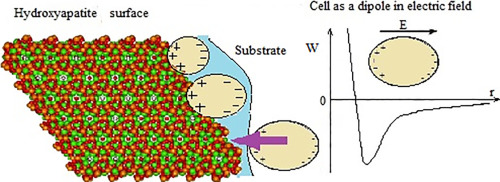Advances in Colloid and Interface Science ( IF 15.9 ) Pub Date : 2017-05-03 , DOI: 10.1016/j.cis.2017.05.002 Vladimir Bystrov , Anna Bystrova , Yuri Dekhtyar

|
Nanostructured hydroxyapatite (HAP) and its nanoparticles are widely used for implantation into the human organism. The biocompatibility of the implants depends very much on the interaction between the implant and the cells regenerating tissue to be connected to the implant. An implant surface electrical charged density plays an important role in these processes. Possible instruments managing the surface electrical potential of HAP are in the focus of this paper. Both theoretical and experimental results evidence that:
- the surface electrical charge density of the nanoparticle depends on its size and shape;
- the electrical charge density of HAP could be engineered by contact less technique because of deposition of the electrical charge from the external radiation source, surface couples reconstruction.
中文翻译:

HAP纳米颗粒和基质表面对骨细胞粘附的电势:最新结果综述
纳米羟基磷灰石(HAP)及其纳米颗粒被广泛用于植入人体。植入物的生物相容性在很大程度上取决于植入物与细胞再生组织之间的相互作用,该细胞将与植入物相连。植入物表面带电密度在这些过程中起着重要作用。管理HAP表面电势的可能手段是本文的重点。理论和实验结果均表明:
-纳米粒子的表面电荷密度取决于其尺寸和形状;
-HAP的电荷密度可以通过无接触技术进行设计,因为来自外部辐射源的电荷沉积,表面耦合重建。











































 京公网安备 11010802027423号
京公网安备 11010802027423号